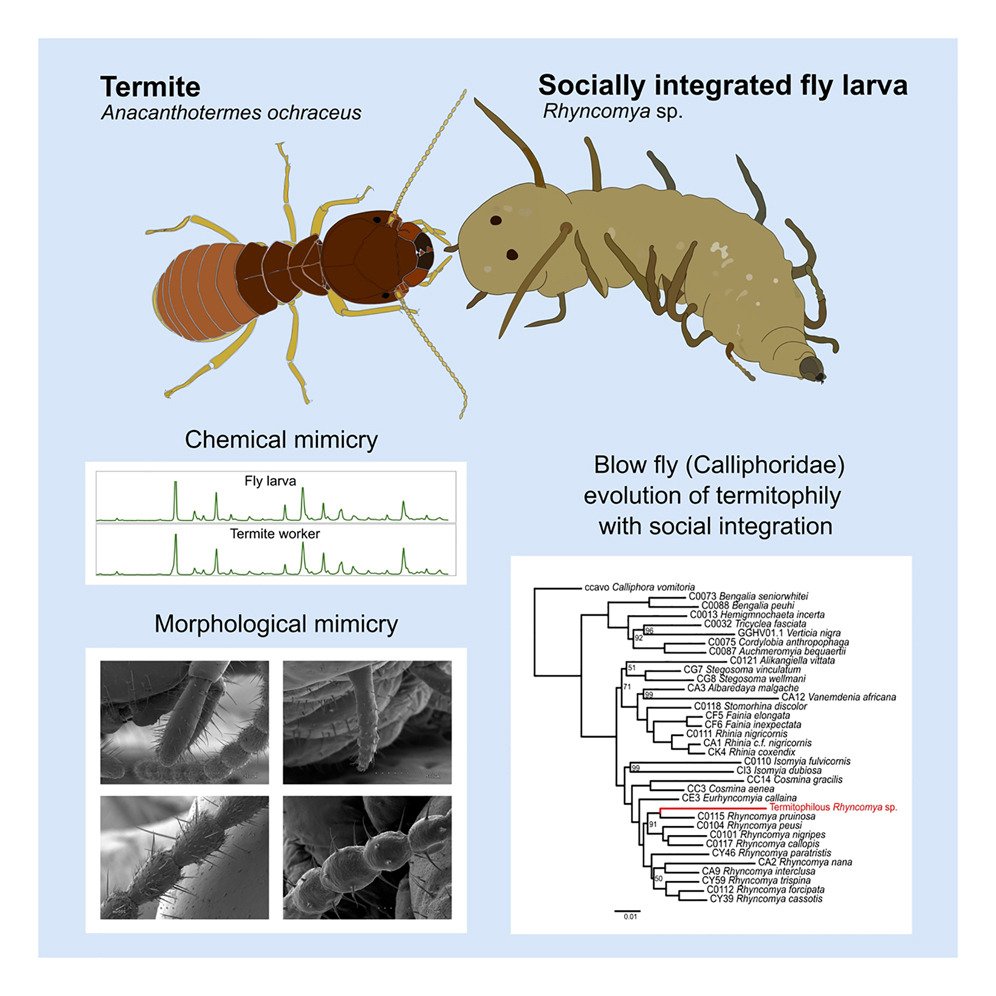Scientists uncover how fly larvae use “Terminator” level mimicry to infiltrate and exploit termite societies, a biological heist 150 million years in the making.
The Ultimate Infiltration: A Fly in Termite’s Clothing

Deep within Moroccan termite mounds, researchers have discovered a masterclass in biological espionage:
- Blow fly larvae (Rhyncomya sp.) living undetected in Anacanthotermes ochraceus colonies
- Chemical camouflage: Cuticular hydrocarbons perfectly mimic host termite scent
- Physical deception: Rear body mimics termite heads; papillae imitate antennae
“This isn’t just mimicry, it’s a full identity theft operation,” says lead author Dr. Jessica Ware (American Museum of Natural History).
Breaking the Fortress: How Fly Larvae Hack Termite Society
Termite nests are among nature’s most secure environments. The larvae’s infiltration toolkit includes:
| Defense Mechanism | Fly Countermeasure |
| Chemical recognition | Identical hydrocarbon profile |
| Tactile inspection | Antenna-like papillae (12x body length) |
| Visual cues | Rear-end “termite head” decoy |
Shock finding: Termites groom the larvae like nestmates a first observed in Diptera.
Evolution’s Greatest Con Artists

Phylogenomic analysis reveals this is no fluke:
- Convergent evolution: Fly lineages independently evolved termitophily 3+ times
- Deep time deception: Last common ancestor with termite-parasitic scuttle flies lived 150 million years ago
- Taxonomic surprise: Links the enigmatic Prosthetosomatinae subfamily to Rhiniinae blow flies
“Nature keeps reinventing the Trojan horse,” notes co-author Dr. Dalton de Souza Amorim.
The Termite Nursery Heist
- Why risk infiltrating a militarized insect society? The rewards are immense:
- Constant temperature/humidity
- Predator-free environment
- Regurgitated food from worker termites
- Protection during vulnerable larval stage
Irony: The very traits that make termites successful social insects (chemical communication, altruism) are exploited by their enemies.
A 48-Hour Transformation

Larvae undergo rapid changes upon nest entry:
- Hour 0-6: Shed external cuticle to absorb colony scent
- Hour 6-24: Papillae elongate to mimic antennae
- Hour 24-48: Rear body swells into “false head”
“It’s like a spy applying prosthetic disguises but biologically encoded,” marvels Ware.
Broader Implications: From Evolution to Pest Control
This discovery reshapes our understanding of:
- Social parasite evolution: Multiple pathways to integration exist
- Chemical ecology: Scent mimicry can override visual/tactile cues
- Biological control: Potential for disrupting pest termite colonies
Next frontier: Researchers are now studying whether adult flies retain any termite-mimicking traits.
Sources:
Fly with fake termite face discovered , Source: YouTube , Uploaded: Cell Press

Jan loves Wildlife and Animals and is one of the founders of Animals Around The Globe. He holds an MSc in Finance & Economics and is a passionate PADI Open Water Diver. His favorite animals are Mountain Gorillas, Tigers, and Great White Sharks. He lived in South Africa, Germany, the USA, Ireland, Italy, China, and Australia. Before AATG, Jan worked for Google, Axel Springer, BMW and others.




